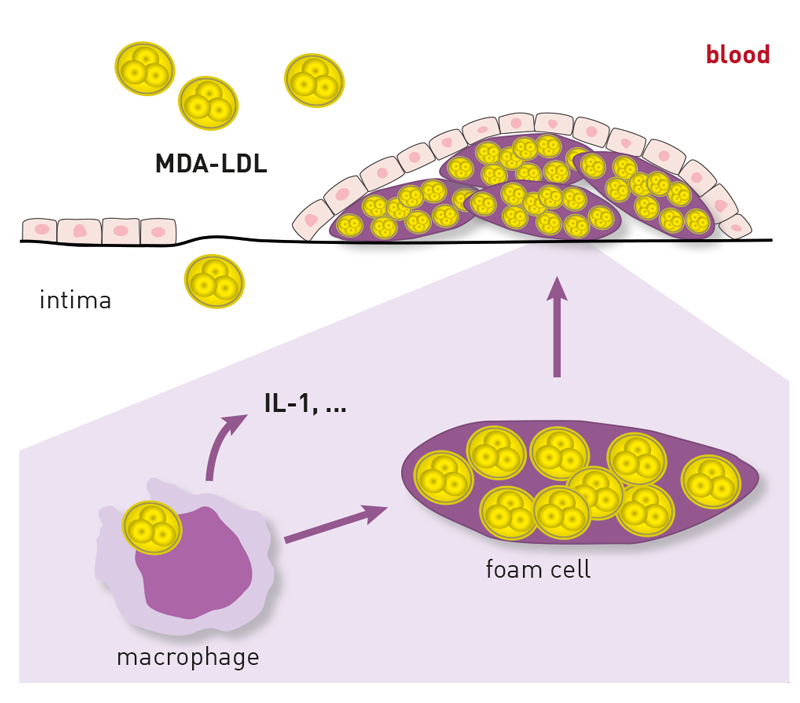Malondialdehyde-modified LDL (MDA-LDL) during oxidative stress
Oxidative stress is a metabolic state where an oversupply of reactive oxygen species is emitted. Those radicals (O2−, H2O2 and OH∙) are produced in the mitochondrial electron transport chain and due to the activity of cytochrome P450 oxidases.
They attack lipids, proteins and DNA and can thus do degenerative damage to the organism.
MDA-LDL is a biomarker for systemic oxidative stress
Malondialdehyde (MDA), a result of oxidative fatty acid degeneration, is a laboratory diagnostic marker for lipid peroxidation. MDA has cytotoxic effects, since it oxidises DNA, proteins and lipids and establishes cross links between amino acids’ side groups. MDA attacks LDL cholesterol particles as well, with Malondialdehyde-modified LDL (MDA-LDL) as a result. Hence, MDA-LDL constitutes a marker that renders damaging effects of MDA in the organism quantifiable. Its detection indicates systemic effects of persisting oxidative stress.
In contrast to MDA, MDA-LDL has a longer half-life and therefore allows for conclusions regarding the middle-term oxidative metabolic state.
MDA-LDL is a cardiovascular risk marker, independent from the overall LDL
Increased LDL cholesterol levels are a risk factor for coronary diseases. Its oxidised forms, such as MDA-LDL, are especially atherogenic. Following some studies, MDA-LDL outperforms commonly used laboratory parameters for atherosclerosis regarding sensitivity and specificity (Amaki et al., 2004). In that context, MDA-LDL levels are independent of the overall LDL (Amaki et al., 2004, and following our own observations), and depend on the patient’s individual oxidative metabolic state.

What is MDA-LDL’s atherogenic effect?
Contrary to native LDL cholesterol, MDA-LDL is immunogenic and exists bound to antibodies in blood. Those MDALDL immune complexes enter the intima through lesions in the vascular endothelium and are subsequently absorbed by macrophages, which as a consequence induce chronic inflammatory responses. Simultaneously, they form, due to the progressive phagocytose of MDA-LDL immune complexes, so called “foam cells”. Lipid-cluttered foam cells accumulate as atherosclerotic plaques at vascular walls.
Indication
- Detection of lipid and protein damage due to oxidative stress
- Risk marker for atherosclerosis
Material
1 ml serum
Costs
Please obtain the costs for the analysis from the pdf-document.
Would you like to see a presentation on the matter?
In our video archive, you can find a free presentation on this topic. Access is free and possible without prior registration.
Literature
- Amaki et al., Heart. 2004, 90: 1211-1213.
- Lopes-Virella and Virella, Clin Immunol. 2010, 134: 55-65.
- Tanaga et al., Arterioscler Thromb Vasc Biol. 2002, 22: 662-6 66.
- Viigimaa et al., Blood Press. 2010, 19: 164-168.
